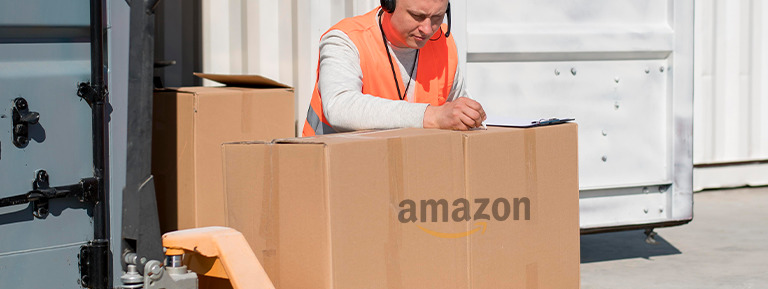Optimizing Your Amazon Seller Experience with Seller Mobile Software and Amazon Logistics
When it comes to selling on Amazon, ensuring customer satisfaction and reducing shipping time are crucial objectives. That’s where Amazon Logistics comes into play. With its innovative features, such as 2-hour delivery even on Sundays, it takes virtual shopping to a whole new level.
However, as a third-party seller, your success with Amazon Logistics depends on how effectively you utilize the program. It can either enhance your ability to serve customers and provide faster delivery or potentially harm your feedback and ratings.
To make the most of Amazon Logistics without compromising your reputation or sales, it’s essential to approach it with a proactive mindset and strategic utilization. This is where seller mobile software comes in, offering valuable tools and insights to optimize your Amazon seller experience.
By leveraging seller mobile software alongside Amazon Logistics, you can streamline your operations, manage inventory efficiently, improve customer satisfaction, and ultimately boost your sales. It empowers you to make informed decisions, stay on top of your orders, and ensure a seamless shopping experience for your customers.
So, whether you’re a seasoned Amazon seller or just starting out, let’s dive into the various perspectives and strategies to help you maximize the benefits of Amazon Logistics while safeguarding your business’s reputation and growth.
Boosting Your Amazon Seller Business with Seller Mobile Software: An Introduction to Amazon Logistics
Are you an Amazon seller looking to optimize your shipping and delivery processes? Meet Amazon Logistics, a renowned shipping and delivery service that works hand-in-hand with established providers like USPS, FedEx, and UPS.
In simple terms, Amazon Logistics acts as a “last mile” delivery service, ensuring that packages reach customers efficiently. It functions similarly to national postal services such as USPS and commercial carriers like FedEx and UPS.
However, Amazon Logistics differentiates itself by operating as a technology-driven marketplace or network, akin to Uber. In this model, Amazon acts as the buyer of delivery services, while independent delivery services and individuals serve as suppliers.
Delivery capacity is provided by two main sources:
1. Individual drivers who utilize Amazon Flex to deliver shipments on their own schedule, embodying the “gig economy” model.
2. Independent delivery services, known as Amazon DSPs (Delivery Service Partners), equipped with their own vans and employed drivers dedicated to daily shipments for Amazon.
It’s important to note that both types of delivery providers are not Amazon employees. Instead, they operate under Amazon’s contract and adhere to its standards while enjoying flexibility in their operations.
Amazon Logistics offers two delivery options: same-day and 7-day, ensuring speedy and reliable service across the country. Delivery partners include various modes of transportation, including bicycles, motorcycles, and even walkers in specific regions. While third-party providers must comply with Amazon’s stipulations regarding vehicles, licensing, insurance, and safety training, they maintain their independence.
These independent logistics providers pick up packages from Amazon warehouses, utilize Amazon’s app for guidance, and register their deliveries. The best part is they enjoy the freedom to choose their preferred pickup timings.
If you’re an Amazon seller seeking to enhance your shipping and delivery operations, consider leveraging seller mobile software. This powerful tool can empower you with valuable insights, efficient inventory management, and exceptional customer support to maximize your Amazon business’s success.
For more expert advice on reducing your Amazon pick and pack fees and optimizing your operations, be sure to check out our recommended guide: “10 Ways to Reduce Your Amazon Pick and Pack Fees.”
Boost Your Income and Flexibility with Amazon Flex: An Overview

Are you looking for a flexible gig that allows you to work on your own terms and earn income based on your hours worked? Introducing Amazon Flex, a temporary gig economy opportunity offered by Amazon.
With Amazon Flex, you have the freedom to choose flexible “blocks” of time to work, giving you complete control over your schedule. You get paid for the number of hours you work, providing an excellent opportunity to generate extra income.
To become an Amazon Flex worker, simply follow Amazon’s process and meet their performance standards. This incredible opportunity has garnered high appreciation and continues to receive a great response from individuals seeking flexibility and additional earnings.
If you’re interested in exploring the benefits of Amazon Flex and maximizing your earning potential, consider leveraging seller mobile software. This powerful software can provide you with valuable tools, insights, and features to streamline your Amazon business, optimize your operations, and enhance your overall success.
Unlock the possibilities with Amazon Flex and seller mobile software today!
The Benefits of Amazon Launching Their Own Logistics: Revolutionizing eCommerce Shipping
Why did Amazon take matters into their own hands and establish their own logistics system? The answer is simple: eCommerce shipping has always been plagued by unreliability and disorganization. Sellers face numerous challenges once their shipments leave the warehouses, leaving them at the mercy of external delivery companies and unpredictable circumstances.
From accidents and breakdowns to customers not being available for delivery, roadwork, and traffic congestion, there are countless factors that can disrupt the shipping process. It’s no wonder that shipping-related complaints, such as late deliveries, shipping damages, and inconvenient delivery times, dominate customer grievances.
By creating its own delivery network, Amazon takes full control and leverages technology to monitor and address these challenges effectively. With their own logistics in place, they can provide a seamless shipping experience and tackle customer concerns head-on.
Moreover, Amazon’s investment in their logistics infrastructure not only ensures better customer satisfaction but also reduces costs and increases delivery capacity. In fact, in 2017 alone, Amazon spent an astonishing $21.7 billion on shipping expenses. With their own logistics network, they can optimize operations, streamline processes, and ultimately enhance the overall efficiency of their shipping services.
As an Amazon seller, it’s crucial to stay ahead of the curve and capitalize on the advantages offered by Amazon’s logistics system. By incorporating seller mobile software into your operations, you can further optimize your shipping processes, track deliveries, and ensure customer satisfaction.
Discover the power of seller mobile software in conjunction with Amazon’s logistics network and revolutionize your eCommerce shipping experience. Maximize efficiency, minimize disruptions, and deliver a seamless experience to your customers, all while driving growth and success in your Amazon business.
How Does Seller Mobile Differ from Conventional Carriers?

When it comes to conventional carriers, they are often perceived as reliable but resistant to change. These carriers adhere to certain practices, including delivering packages during regular business hours and on weekdays, requiring a recipient’s signature for delivery, and prioritizing security over convenience. While these practices have their merits and can ensure professionalism, they may lack some of the flexibility and customer-centric features that Amazon Logistics offers.
Amazon Logistics challenges these conventions and aims to provide a more customer-focused and innovative delivery experience. With seller mobile software, Amazon sellers can unlock a range of benefits that set it apart from traditional carriers:
1. Expanded Delivery Options: Unlike conventional carriers, Amazon Logistics offers deliveries during weekends, evenings, and holidays. This flexibility accommodates customers’ busy schedules and ensures convenient access to their packages at their preferred times.
2. Enhanced Security Measures: Seller mobile software enables sellers to offer options such as leaving orders with neighbors, ensuring the package is secure rather than leaving it unattended at the recipient’s doorstep. This added security feature provides peace of mind for both sellers and customers.
3. Streamlined Delivery Process: With Amazon Logistics and the seller mobile software, there is no requirement for a recipient’s signature for every delivery. This streamlined process saves time and eliminates the inconvenience of waiting for a signature, making the delivery experience more efficient and hassle-free.
By leveraging seller mobile software alongside Amazon Logistics, Amazon sellers can tap into these differentiating factors to elevate their delivery services. Expand your reach, cater to customer preferences, and provide a secure and convenient delivery experience that sets you apart from conventional carriers. With the power of seller mobile software, enhance your Amazon business and exceed customer expectations.
How Does Seller Mobile Enhance Amazon Logistics?

Seller mobile software plays a crucial role in optimizing and enhancing the efficiency of Amazon Logistics for sellers. By utilizing seller mobile software, Amazon sellers can effectively leverage the benefits of Amazon Logistics and provide a seamless delivery experience to their customers. Here’s how it works:
1. Real-time Delivery Updates: Seller mobile software allows sellers to receive real-time updates on their Amazon Logistics shipments. This enables sellers to track the progress of their deliveries and keep their customers informed about the estimated delivery timeframes.
2. Efficient Order Management: With seller mobile software, sellers can efficiently manage their Amazon Logistics orders. They can easily process and fulfill orders, print shipping labels, and generate necessary documentation, all within the software’s user-friendly interface. This streamlines the order management process and saves time for sellers.
3. Inventory Optimization: Seller mobile software provides valuable insights into inventory management. Sellers can monitor stock levels, track product availability, and receive notifications for low inventory. This helps sellers ensure that they have sufficient stock to fulfill Amazon Logistics orders promptly.
4. Customer Communication: Effective communication is key to providing a positive customer experience. Seller mobile software enables sellers to interact with customers directly through messaging features. Sellers can address customer inquiries, provide order updates, and resolve any issues promptly, leading to improved customer satisfaction.
5. Performance Analysis: Seller mobile software offers performance analytics and reporting tools. Sellers can analyze key metrics related to their Amazon Logistics shipments, such as delivery times, customer feedback, and overall performance. This data-driven approach allows sellers to identify areas for improvement and optimize their logistics operations accordingly.
By utilizing seller mobile software alongside Amazon Logistics, sellers can maximize the benefits of this service and provide an exceptional delivery experience to their customers. The software streamlines operations, enhances communication, and provides valuable insights to help sellers achieve success in their Amazon business.
What Does Seller Mobile Mean for Amazon Sellers?
For Amazon sellers, the integration of Seller Mobile software with Amazon Logistics brings significant benefits and opportunities. Here’s what it means for sellers:
1. Seamless Tracking and Delivery: With Seller Mobile, Amazon Logistics shipments are easily traceable with the tracking label AMZL_US. This allows sellers to monitor the progress of their deliveries and provide accurate updates to their customers. Sellers can ensure that their packages reach special sorting centers and are efficiently delivered to customers on time.
2. Enhanced Efficiency and Control: Seller Mobile software enables delivery drivers to install Amazon’s mobile app, empowering them to efficiently plan routes, navigate, and manage customer service. Sellers can leverage this technology to streamline their logistics operations, ensuring smooth and timely deliveries.
3. Differentiation from Conventional Carriers: While established carriers like UPS, USPS, and FedEx have standard service levels, Amazon Logistics may offer a unique delivery experience. The performance of Amazon Logistics can vary among different Delivery Service Partners (DSPs). Sellers should be aware of this difference and adapt their strategies accordingly to meet customer expectations.
4. Opportunities for Customer Satisfaction: Seller Mobile provides sellers with tools to optimize customer satisfaction. By leveraging the app’s features and functionalities, sellers can provide exceptional customer service, address inquiries promptly, and resolve issues effectively. This can lead to higher customer satisfaction ratings and positive reviews, ultimately benefiting the seller’s reputation and sales.
5. Challenges and Solutions: It’s important for sellers to recognize that Amazon Logistics’ delivery experience can sometimes be unpredictable. While this can present challenges, sellers can mitigate the impact by closely monitoring and managing their logistics operations using Seller Mobile. Sellers can proactively communicate with customers, provide accurate delivery timeframes, and ensure the best possible delivery experience.
In summary, Seller Mobile software empowers Amazon sellers to optimize their logistics operations, enhance customer satisfaction, and navigate the unique aspects of Amazon Logistics. By leveraging these tools effectively, sellers can stand out in the marketplace and provide exceptional service to their customers.
Potential Negative Impacts for Amazon Sellers:

The success of third-party sellers on Amazon heavily relies on their Seller Feedback rating, which has a significant influence on winning the Buy Box and shaping buyers’ perceptions. Shipping plays a crucial role in this aspect, as damaged or mishandled packages can result in negative seller feedback.
Fortunately, sellers using FBA (Fulfillment by Amazon) or Seller-Fulfilled Prime benefit from Amazon handling item replacement and customer support for damaged or lost orders. Additionally, Amazon’s A-Z Guarantee Claim provides protection for buyers purchasing from third-party merchants.
Unfortunately, frustrated customers are more likely to express their dissatisfaction through negative feedback, especially related to delivery issues. Sellers have no control over which logistics provider is used to ship their packages. So, what can sellers do to mitigate these challenges?
Active engagement is key.
As a seller, it is essential to proactively communicate with each customer, reaching out to them at least once. Timely follow-up can help reduce the occurrence of negative reviews. To achieve this, leveraging a reliable Buyer-Seller Messaging system that automates tasks can be highly beneficial. Such a system streamlines communication with customers and ensures timely and effective interactions. By adopting proactive measures, sellers can enhance customer satisfaction and minimize the impact of potential negative feedback.
In summary, being proactive and utilizing efficient communication tools like a Buyer-Seller Messaging system can help Amazon sellers navigate the potential negative consequences associated with shipping and delivery, ultimately improving their Seller Feedback rating and overall success on the platform.
Pros and Cons of Amazon Logistics:

Like any other program, Amazon Logistics has its own advantages and disadvantages. Let’s explore them:
Pros:
1. Faster Delivery: Amazon Logistics enables faster delivery options, including 2-hour and same-day shipping, in select areas. This allows sellers to offer expedited service and access programs like Amazon Fresh, Lockers, Prime Air, and Flex.
2. Enhanced Tracking: Customers can enjoy the convenience of enhanced map tracking and receive photo confirmation once their parcel is delivered, adding an extra layer of transparency.
3. High Demand Fulfillment: During peak seasons or high shipping volumes, Amazon Logistics maintains a steady pace, preventing overcrowding in warehouses and ensuring timely deliveries.
4. Global Growth Opportunities: The collaboration between internal teams and external partners facilitates global expansion and the introduction of innovative initiatives such as Amazon Fresh, Amazon Flex, Amazon Lockers, and Prime Air.
Cons:
1. Limited Control Over Delivery Providers: Sellers cannot choose specific delivery providers for their orders, which means any negative experiences with the provider may be repeated.
2. Impact on Feedback Rating: Any mishandled or delayed deliveries through Amazon Logistics can negatively impact a seller’s feedback rating, potentially affecting their sales performance.
3. Lack of Seller Control: Sellers have little to no control over Amazon Logistics, as the program currently operates without seller input. This limits the ability to provide insights and suggestions for process improvement.
4. Inconsistent Delivery Protocols: Independent delivery services associated with Amazon Logistics may not always adhere to protocols correctly, particularly when dealing with undeliverable orders.
In summary, Amazon Logistics offers faster delivery, enhanced tracking, and global growth opportunities for sellers. However, the lack of control over delivery providers and the potential impact on feedback ratings are significant drawbacks. Sellers should weigh these pros and cons when considering the use of Amazon Logistics for their shipping needs.
To Minimize the Risks of Amazon Logistics:

When it comes to your reputation and sales, it’s crucial to have a practical action plan in place from the moment of sale to delivery. Here are some strategies to minimize the risks associated with Amazon Logistics:
1. Utilize an Automated Messaging System: Implement a reliable automated messaging system that sends a feedback request to customers immediately after their product is delivered. Prompt communication can help address any concerns and encourage positive feedback.
2. Provide Multiple Contact Options: Ensure that your customers have various channels to reach out to you. By offering multiple options for contacting customer support, you demonstrate your commitment to resolving any service or shipping issues promptly. Include links to track orders, your Amazon storefront, and review pages to facilitate communication.
3. Explore Alternative Shipping Methods: If you find that customers are hesitant to choose Amazon Logistics as their preferred shipping option, consider reaching out to customer service. Requesting alternative shipping methods for specific orders might encourage customers to explore other options, minimizing the reliance on Amazon Logistics.
4. Maintain Frequent Communication: Regularly engage with your customers to build trust and address any concerns they may have. By implementing these strategies, you can proactively prevent negative reviews and feedback, while still benefiting from the convenience of the Amazon Logistics program.
By prioritizing customer satisfaction and maintaining open lines of communication, you can mitigate the risks associated with Amazon Logistics and ensure a positive experience for your customers.
CONCLUSION
In conclusion, Amazon Logistics offers numerous benefits for Amazon sellers, including faster delivery options, enhanced tracking, and global growth opportunities. However, it also comes with some potential challenges, such as limited control over delivery providers and the potential impact on feedback ratings. To unlock the benefits of Amazon Logistics while safeguarding your business’s reputation and growth, it is essential to approach it with a proactive mindset and strategic utilization.
One effective way to optimize your Amazon seller experience with Amazon Logistics is by leveraging seller mobile software. This powerful tool provides valuable insights, efficient inventory management, and exceptional customer support. By utilizing seller mobile software alongside Amazon Logistics, you can streamline your operations, manage inventory efficiently, improve customer satisfaction, and ultimately boost your sales.
Furthermore, active engagement with customers through proactive communication is crucial in mitigating potential negative impacts. Leveraging a reliable Buyer-Seller Messaging system can help sellers streamline communication with customers, ensuring timely and effective interactions. By adopting proactive measures, sellers can enhance customer satisfaction and minimize the impact of potential negative feedback.
It is important for sellers to weigh the pros and cons of Amazon Logistics before deciding to use the service. While it offers faster delivery, enhanced tracking, and global growth opportunities, it also comes with limitations in control over delivery providers and potential impacts on feedback ratings. Sellers should consider these factors and develop a practical action plan to minimize the risks associated with Amazon Logistics.
In conclusion, by approaching Amazon Logistics with a proactive mindset, leveraging seller mobile software, and implementing effective communication strategies, sellers can unlock the benefits of the service while mitigating potential risks. By optimizing their Amazon seller experience with Amazon Logistics, sellers can provide exceptional service to their customers, enhance their reputation, and drive growth and success in their Amazon business.

Unlock the full potential of your Amazon seller journey by taking advantage of the Seller Mobile application. Streamline your operations, manage inventory with ease, and provide top-notch customer service. Don’t miss out – empower your Amazon business today with Seller Mobile!




